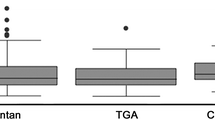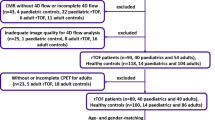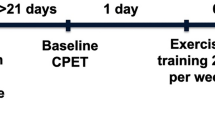Abstract
Fontan completion, resulting in a total cavopulmonary connection (TCPC), is accomplished using a lateral tunnel (LT), extracardiac conduit (ECC), or recently a bifurcated Y-graft. The local energetic differences between these graft types have not been substantially analyzed under exercise conditions. The present study evaluates the energetic performance of Y-grafts under simulated exercise conditions, compares their performance to the previous LT/ECC Fontan options, and discusses implications for exercise tolerance and hemodynamic predictability. Twenty Y-graft and 20 LT/ECC patients were analyzed. TCPC anatomies and flow waveforms were reconstructed using patient-specific cardiac magnetic resonance (CMR) images and phase-contrast CMR. Computational fluid dynamics simulations were performed to quantify indexed power loss (iPL) under both resting and simulated exercise conditions. Comparisons between graft types were investigated. iPL was significantly higher (p < 0.01) for Y-grafts at all activity levels. No significant interaction effects were observed between graft type and activity level. iPL at rest was strongly correlated (r 2 = 0.97, p < 0.001) with iPL at moderate exercise for Y-grafts, but less so for the LT/ECC cohort (r 2 = 0.66, p < 0.001). Similar results were seen for intense exercise, with a strong correlation for Y-grafts (r 2 = 0.94, p < 0.001) and a moderate correlation for LT/ECC (r 2 = 0.52, p < 0.001). Commercially available Y-grafts were found to have significantly higher iPL at all activity levels, suggesting worse exercise tolerance than the LT/ECC alternatives. Y-grafts offered impressive hemodynamic predictability which was not seen in the LT/ECC cohort. Our results encourage the further evaluation of an area-preserving Y-graft design to offer both improved energetic performance and hemodynamic predictability. Commercial Y-grafts show worse energetics, but more predictable responses than traditional Fontan connections under simulated exercise conditions. During simulated exercise conditions, commercially available Y-grafts show predictable but inferior energetic performance compared to lateral tunnel and extracardiac conduit Fontan connections, suggesting poorer exercise capacity. If Y-graft use is continued, these results encourage further evaluation of a cross sectional area-preserving Y-graft design as a additional alternative for Fontan completion.






Similar content being viewed by others
Abbreviations
- BSA:
-
Body surface area
- CFD:
-
Computational fluid dynamics
- CMR:
-
Cardiac magnetic resonance
- ECC:
-
Extracardiac conduit
- HLHS:
-
Hypoplastic left heart syndrome
- iPL:
-
Indexed power loss
- IVC:
-
Inferior vena cava
- LPA:
-
Left pulmonary artery
- LT:
-
Lateral tunnel
- PA:
-
Pulmonary artery
- PL:
-
Power loss
- Qs:
-
Systemic flow
- RPA:
-
Right pulmonary artery
- SVC:
-
Superior vena cava
- TCPC:
-
Total cavopulmonary connection
References
Fontan, F., and E. Baudet. Surgical repair of tricuspid atresia. Thorax. 26(3):240–248, 1971. doi:10.1136/thx.26.3.240.
Shah, M. J., J. Rychik, M. A. Fogel, J. D. Murphy, and M. L. Jacobs. Pulmonary AV malformations after superior cavopulmonary connection: resolution after inclusion of hepatic veins in the pulmonary circulation. Ann. Thorac. Surg. 63(4):960–963, 1997.
Duncan, B. W., and S. Desai. Pulmonary arteriovenous malformations after cavopulmonary anastomosis. Ann. Thorac. Surg. 76(5):1759–1766, 2003. doi:10.1016/S0003-4975(03)00450-8.
Trusty, P. M., M. Restrepo, K. R. Kanter, A. P. Yoganathan, M. A. Fogel, and T. C. Slesnick. A pulsatile hemodynamic evaluation of the commercially available bifurcated Y-graft Fontan modification and comparison with the lateral tunnel and extracardiac conduits. J. Thorac. Cardiovasc. Surg. 2016. doi:10.1016/j.jtcvs.2016.03.019.
Restrepo, M., L. Mirabella, E. Tang, et al. Fontan pathway growth: a quantitative evaluation of lateral tunnel and extracardiac cavopulmonary connections using serial cardiac magnetic resonance. Ann. Thorac. Surg. 97(3):916–922, 2014. doi:10.1016/j.athoracsur.2013.11.015.
Haggerty, C. M., M. Restrepo, E. Tang, et al. Fontan hemodynamics from 100 patient-specific cardiac magnetic resonance studies: a computational fluid dynamics analysis. J. Thorac. Cardiovasc. Surg. 148(4):1–10, 2013. doi:10.1016/j.jtcvs.2013.11.060.
Tang, E., M. Restrepo, C. M. Haggerty, et al. Geometric characterization of patient-specific total cavopulmonary connections and its relationship to hemodynamics. JACC Cardiovasc. Imaging. 7(3):215–224, 2014. doi:10.1016/j.jcmg.2013.12.010.
Kanter, K. R., C. M. Haggerty, M. Restrepo, et al. Preliminary clinical experience with a bifurcated Y-graft Fontan procedure—a feasibility study. J. Thorac. Cardiovasc. Surg. 144(2):383–389, 2012. doi:10.1016/j.jtcvs.2012.05.015.
Yang, W., F. P. Chan, V. M. Reddy, A. L. Marsden, and J. A. Feinstein. Flow simulations and validation for the first cohort of patients undergoing the Y-graft Fontan procedure. J. Thorac. Cardiovasc. Surg. 149(1):247–255, 2015. doi:10.1016/j.jtcvs.2014.08.069.
Yang, W., J. A. Feinstein, S. C. Shadden, I. E. Vignon-Clementel, and A. L. Marsden. Optimization of a Y-graft design for improved hepatic flow distribution in the Fontan circulation. J. Biomech. Eng. 135(1):011002, 2013. doi:10.1115/1.4023089.
Marsden, A. L., A. J. Bernstein, V. M. Reddy, et al. Evaluation of a novel Y-shaped extracardiac Fontan baffle using computational fluid dynamics. J. Thorac. Cardiovasc. Surg. 137(2):394–403, 2009. doi:10.1016/j.jtcvs.2008.06.043.
Pundi, K. N., J. N. Johnson, J. A. Dearani, et al. 40-Year follow-up after the Fontan operation long-term outcomes of 1,052 patients. J Am Coll Cardiol. 66(15):1700–1710, 2015. doi:10.1016/j.jacc.2015.07.065.
Giardini, A., A. Hager, C. Pace Napoleone, and F. M. Picchio. Natural history of exercise capacity after the Fontan operation: a longitudinal study. Ann. Thorac. Surg. 85(3):818–821, 2008. doi:10.1016/j.athoracsur.2007.11.009.
Driscoll, D. J., G. K. Danielson, F. J. Puga, H. V. Schaff, C. T. Heise, and B. A. Staats. Exercise tolerance and cardiorespiratory response to exercise after the Fontan operation for tricuspid atresia or functional single ventricle. J. Am. Coll. Cardiol. 7(5):1087–1094, 1986. doi:10.1016/S0735-1097(86)80227-3.
Fredriksen, P. M., J. Therrien, G. Veldtman, et al. Lung function and aerobic capacity in adult patients following modi ed Fontan procedure. Society. 295–299, 2001.
Paridon, S. M., P. D. Mitchell, S. D. Colan, et al. A cross-sectional study of exercise performance during the first 2 decades of life after the Fontan operation. J. Am. Coll. Cardiol. 52(2):99–107, 2008. doi:10.1016/j.jacc.2008.02.081.
Ohuchi, H., J. Negishi, K. Noritake, et al. Prognostic value of exercise variables in 335 patients after the fontan operation: a 23-year single-center experience of cardiopulmonary exercise testing. Congenit. Heart Dis. 10(2):105–116, 2015. doi:10.1111/chd.12222.
Gewillig, M. H., U. R. Lundström, J. E. Deanfield, et al. Impact of Fontan operation on left ventricular size and contractility in tricuspid atresia. Circulation. 81(1):118–127, 1990. doi:10.1161/01.CIR.81.1.118.
Sluysmans, T., P. S. Sanders, M. Van Der Velde, et al. Natural history and patterns of recovery of contractile function in single left ventricle after Fontan operation. Circulation. 86:1753–1761, 1992.
Rowe, S. A., K. G. Zahka, T. A. Manolio, P. J. Horneffer, and L. Kidd. Lung function and pulmonary regurgitation limit exercise capacity in postoperative tetralogy of Fallot. J. Am. Coll. Cardiol. 17(2):461–466, 1991. doi:10.1016/S0735-1097(10)80116-0.
Grewal, J., R. B. Mccully, G. C. Kane, C. Lam, P. A. Pellikka, and Factors NY. Left ventricular function and exercise capacity. Jama 301(3):286–294, 2009.
Lewis, G. D., R. Shah, K. Shahzad, et al. Sildenafil improves exercise capacity and quality of life in patients with systolic heart failure and secondary pulmonary hypertension. Circulation. 116(14):1555–1562, 2007. doi:10.1161/CIRCULATIONAHA.107.716373.
Whitehead, K. K., K. Pekkan, H. D. Kitajima, A. P. Yoganathan, and M. A. Fogel. Nonlinear power loss during exercise in single-ventricle patients after the Fontan: insights from computational fluid dynamics. Circulation 2007. doi:10.1161/CIRCULATIONAHA.106.680827.
Khiabani, R. H., K. K. Whitehead, D. Han, et al. Exercise capacity in single-ventricle patients after Fontan correlates with haemodynamic energy loss in TCPC. Heart. 101(2):139–143, 2015. doi:10.1136/heartjnl-2014-306337.
Yang, W., I. E. Vignon-Clementel, G. Troianowski, V. M. Reddy, J. A. Feinstein, and A. L. Marsden. Hepatic blood flow distribution and performance in conventional and novel Y-graft Fontan geometries: a case series computational fluid dynamics study. J. Thorac. Cardiovasc. Surg. 143(5):1086–1097, 2012. doi:10.1016/j.jtcvs.2011.06.042.
Frakes, D. H., M. J. T. Smith, J. Parks, S. Sharma, S. M. Fogel, and A. P. Yoganathan. New techniques for the reconstruction of complex vascular anatomies from MRI images. J. Cardiovasc. Magn. Reson. 7(2):425–432, 2005. doi:10.1081/JCMR-200053637.
Frakes, D. H., C. P. Conrad, T. M. Healy, et al. Application of an adaptive control grid interpolation technique to morphological vascular reconstruction. IEEE Trans. Biomed. Eng. 50(2):197–206, 2003. doi:10.1109/TBME.2002.807651.
Frakes, D., M. Smith, D. de Zélicourt, K. Pekkan, and A. Yoganathan. Three-dimensional velocity field reconstruction. J. Biomech. Eng. 126(6):727, 2004. doi:10.1115/1.1824117.
Sundareswaran, K. S., D. H. Frakes, M. A. Fogel, D. D. Soerensen, J. N. Oshinski, and A. P. Yoganathan. Optimum fuzzy filters for phase contrast MRI segmentation. J. Magn. Reson. Imaging. 29(1):155–165, 2009. doi:10.1002/jmri.21579.Optimum.
De, Zélicourt D., L. Ge, C. Wang, F. Sotiropoulos, A. Gilmanov, and A. Yoganathan. Flow simulations in arbitrarily complex cardiovascular anatomies—an unstructured Cartesian grid approach. Comput. Fluids. 38(9):1749–1762, 2009. doi:10.1016/j.compfluid.2009.03.005.
Wei, Z., K. K. Whitehead, R. H. Khiabani, et al. Respiratory effects on Fontan circulation during rest and exercise utilizing real time cardiac magnetic resonance imaging. Ann. Thorac. Surg. 2016. doi:10.1016/j.athoracsur.2015.11.011.
Shachar, G. B., B. P. Fuhrman, Y. Wang, R. V. Lucas, and J. E. Lock. Rest and exercise hemodynamics after the Fontan procedure. Circulation. 65(6):1043–1048, 1982. doi:10.1161/01.CIR.65.6.1043.
Gewillig, M. H., U. R. Lundström, C. Bull, R. K. H. Wyse, and J. E. Deanfield. Exercise responses in patients with congenital heart disease after Fontan repair: patterns and determinants of performance. J. Am. Coll. Cardiol. 15(6):1424–1432, 1990. doi:10.1016/S0735-1097(10)80034-8.
Pedersen. E. M., E. V. Stenbøg, T. Fründ, et al. Flow during exercise in the total cavopulmonary connection measured by magnetic resonance velocity mapping. Heart. 2002;87(6):554–558. http://www.scopus.com/inward/record.url?eid=2-s2.0-0036110412&partnerID=40&md5=456e1f006941199d220e9a266922a150.
Cheng, C. P., R. J. Herfkens, A. L. Lightner, C. A. Taylor, and J. A. Feinstein. Blood flow conditions in the proximal pulmonary arteries and vena cavae: healthy children during upright cycling exercise. Am. J. Physiol. Heart Circ. Physiol. 287(2):H921–H926, 2004. doi:10.1152/ajpheart.00022.2004.
Dasi, L. P., K. Pekkan, H. D. Katajima, and A. P. Yoganathan. Functional analysis of Fontan energy dissipation. J. Biomech. 41(10):2246–2252, 2008. doi:10.1016/j.jbiomech.2008.04.011.
Funding
Mark Fogel has received funding through: Research Grant; Modest; NIH R01. Consultant/Advisory Board; Modest; Edwards Lifesciences - MRI Core Lab. Other; Modest; AMAG FACT trial site, Cooley’s Anemia Foundation MRI Core Lab.
Author information
Authors and Affiliations
Corresponding author
Ethics declarations
Conflict of Interest
None of the authors have potential conflicts of interest in relation to the presented work.
Human and Animal Rights
No animal studies were carried out by the authors for this article.
Ethical Approval
All procedures followed were in accordance with the ethical standards of the responsible committee on human experimentation (institutional and national) and with the Helsinki Declaration of 1975, as revised in 2000. Informed consent was obtained from all individual participants included in the study.
Additional information
Associate Editor Pedro del Nido oversaw the review of this article.
Rights and permissions
About this article
Cite this article
Trusty, P.M., Wei, Z., Tree, M. et al. Local Hemodynamic Differences Between Commercially Available Y-Grafts and Traditional Fontan Baffles Under Simulated Exercise Conditions: Implications for Exercise Tolerance. Cardiovasc Eng Tech 8, 390–399 (2017). https://doi.org/10.1007/s13239-017-0310-5
Received:
Accepted:
Published:
Issue Date:
DOI: https://doi.org/10.1007/s13239-017-0310-5




